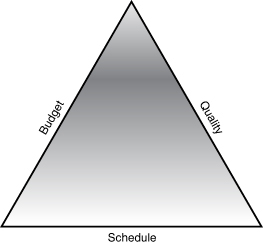Much of your work will ultimately be
reflected in a Microsoft Project schedule, but if you start that
process before you are ready, you can end up with a project that is out
of control. This is because Project was designed to help you manage the
details of your project schedule—the
activities, the calendars, the resources, and many other details that
can be captured and managed. Before you dive into the details, however,
you need to frame the big picture with the following:
Where you are going (your goal and objectives).
What you must provide as results of your project (end products or outcomes, deliverables).
What boundaries and constraints you must work within (regulatory requirements, budgets, time frames, quality levels, and more).
How you will manage change when it happens (and it will happen).
The details that will reside within your Project
schedule will become important, but it is equally important to start
with a well-designed approach that is easy to explain to your team and
to your stakeholders. After that is in place, working out the details
and controlling the scope of the project will be much more manageable.
Define a Measure of Success
Projects are most successful when they are focused on the achievement of one
clear goal. The goal should be measurable and achievable. Project goals
can range from very lofty (putting a man on the moon) to very simple
(reduce errors in a report); if the team can rally behind the goal and
understand the purpose, your chances of success are much improved.
There can be many additional objectives involved in reaching the
project goal that will also need to be defined, so it is extremely
important to reach clarity among the team members and the stakeholders
of the primary driver of the project. After this goal is documented,
all lower-level objectives can be reviewed against this goal to
determine whether they should be included in the scope or should be
defined as out of scope.
The illustration in Figure 1
explains the point. Jigsaw puzzles come in all sizes and shapes but the
point of each is to complete a puzzle. If two puzzles are mixed
together or pieces of one puzzle are missing, you cannot complete the
goal of finishing the puzzle. All of the puzzle pieces (objectives)
must be focused on the same picture and none of them should be missing.

It
is very important that the project has one—and only one—driving goal.
When stakeholders do not agree on the purpose of the project or have
competing needs and objectives, problems occur. A project with multiple
goals can result in a lot of churn when things do not go according to
plan, because the team cannot easily make a decision on which
components are the most critical for project success. Rather than try
to accommodate divergent needs, the project must have one driver. All
additional objectives should support that goal in some way or should be
defined as “out of scope.”
In addition, you must define clear boundaries and
rules of fair play to ensure that reaching the goal is done in a manner
that does not have a negative impact. The next section develops this
idea further.
Clarify the Constraints and Boundaries
This section addresses two topics that are essential
to building a good project schedule. It will help the team understand
what is in scope and what is out of scope. It will also help you and
your team define the work that must be accomplished and the manner in
which it will be done.
Define the Boundaries—Rules of Fair Play
Projects exist in an overall mission context that
they must support and not negatively impact. A set of rules helps
define and guard project boundaries while building a proper framework
that enables flexibility within the project. Rules also ensure the
overall corporate mission context is protected. For example, a company
that produces playground equipment for schools may need to reduce the
costs of its manufacturing process. If the company launches a project
to reduce costs of the manufacturing process, there are hundreds of
ways this could be accomplished. Some of the methods could cause
consumer safety issues. To prevent this, the project team could set a
boundary that states that the injury statistics for the equipment must
not be increased. When the framework is initially set in this way, both
the method in which the project is planned and the way that the project
is measured will be impacted.
Similarly,
putting on man on the moon without getting him back to Earth safely
would not be a successful project outcome. Not all projects have
boundaries that are this critical or visible, but it is easy to see how
they impact the project’s budget, schedule, and quality planning. The
same is true for even the simplest of projects; the team must determine
the rules within which the project will operate. Those decisions will
help you decide what is truly in scope, what is out of scope, as well
as how and when the project will be completed.
Identify Time, Budget, and Quality Constraints
Clarification of the goal and the scope is critical
to obtaining some flexibility in time and budget. In many cases, only
one of the factors (time, budget, or quality) is extremely important,
and it may become a part of the driving goal. For example, it may be
important to be the “first to market” with a particular product
concept. In this case, being first is more critical than being the
best, so the project manager must focus on timely delivery and limit
the number of features or the quality of the product.
Often a project is chartered with preset
expectations of not only what the project will provide but also when it
will be delivered and how much it will cost. If this is the case, the
project manager’s job has little to do with managing a project and much
more to do with managing expectations. Often, when one of the factors
changes, it directly affects the other two. Similarly, if you were to
lengthen or shorten one side of the triangle, one of the other two
sides, or both, have to be adjusted in order to maintain the shape, as
shown in Figure 2.

Regardless of the situation, the project team should
still work with the stakeholders to clarify the goals and the
boundaries before creating a schedule. Even though the tendency is to
get resources engaged in activities as soon as you can, it is more
critical to have all resources working on meeting one clear goal.
Define the Final Deliverables
If
you have ever worked on a project that never seemed to end, it was
probably because there was no clear definition of project completion.
The goal that is set for a project must be measurable, and there must
be a list of deliverables that, once completed, bring the project to a
close.
For a home construction project, the deliverables
would include a completed house, landscaping, and a certificate of
occupancy (CO). Each deliverable must also include a quality component
that can be measured. Because many details must be considered,
homebuilders typically list them in a walkthrough document for the
buyer’s approval. The CO may take some time to achieve, but the final
result is very clear and measurable.
For a software project, some of the final
deliverables would include software, documentation, operational
processes, and training. The quality measures can include things such
as response times, number/severity of errors in the system test, user
acceptance surveys, or other similar measures. The deliverables and the
measures should all relate to the driving goal of the project or at
least support one of the subordinate goals or objectives.
Without clear, measurable deliverables, there is no
way to be sure that all of the stakeholders are in agreement regarding
the project’s goals. The project team may not even have identified some
of the work that the stakeholders are expecting or the quality
expectations may not be achievable within the time and cost constraints
of the project. It is much better to clarify these points during the
planning cycle than to reach the end of the project’s budget and time
and not be able to deliver work that was never defined.
The process of defining end deliverables will very
likely require you to go back and reexamine both the goal and the
constraints and boundaries of the project. This is an iterative process
and it is time well spent. Without this process working through to
completion, you will be creating a list of tasks that may or may not be
useful in reaching your goal. The project will certainly expend a large
amount of effort but may not earn any true value for the stakeholders.
Establish a Change Control Process
The final component of organizing for success is
planning for change. Change is inevitable, no matter how perfectly you
plan. The only thing that you can do is prepare and have a process
ready so that when it happens, your team knows how to respond.
Change control provides the discipline to
identify and communicate the impact of scope changes, quality demands,
risks, issues, and the day-to-day complexities of resource management.
Project will help you identify, manage, and report on project changes,
so it is a good practice to determine the features that you will use
during the planning cycle. For example, establish an expectation for
when you baseline your project, how often you capture a snapshot of the
current schedule, and what criteria you use to determine if you need to
reset the baseline because of scope changes. You should also set up
guidelines for how you will track progress and status and what features
you will use for reporting.